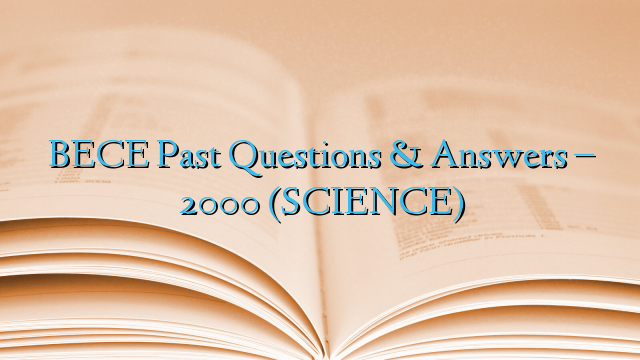BECE Past Questions & Answers – 2000 (SCIENCE)

August2000
SCIENCE
SECTION B ESSAY
1hour
[60 marks]
Answer three questions only from this section.
Illustrate your answers wherever possible, with large, clear and fully labelled diagrams. Credit will be given for clarity of expression and orderly presentation of material.
All questions carry equal marks
1. (a) (i) What is personal hygiene?
(ii) List four ways by which personal hygiene could be maintained
n
2. (a) What is an electrostatic force?
(b) (i) State the unit of
(α) force
(β) work
(ii) A body of mass 80 kg is lifted vertically through a distance of 5.0 m. Calculate the work done on the body.
[Acceleration due to gravity(g)=10 ms-2]
(c) Describe briefly how a mixture of common salt and powdered sulphur could be separated. (d) Statethree characteristicseach of
(i) an insect pollinated flower
(ii) awind pollinated flower
3. (a) (i) (ii) What is fertilization
Describe briefly the processes that lead to fertilization in humans after mating
(b)
(i) (ii)
Define the term density
Describe briefly how the density of a piece of stone could be determined
(c)
(i) (ii)
What is an element?
Classify each of the following substances as an element, compound or mixture: Water, air, potassium, alcohol, common salt, sugar
4. (a) Define each of the following terms:
(i) alloy
(ii) diffusion
(iii) colloid
(b) Give two examples each of:
(i) alloy
(c) (ii)
(i) colloid
What is pollution?
(ii) List two pollutants each of:
(α) air
(β) water
(γ) land
(d) A coconut of weight 50 N hangs 15 m above the ground. (i) Name the type of energy possessed by the coconut. (ii) Calculate the value of this energy CLICK TO VIEW ANSWERS TO PART 2
SCIENCE Section B
SOLUTIONS
ESSAY
1. (a) (i) Personal Hygiene
The practice of cleanliness of a person and his/her physical environment
(ii) Ways by which personal hygiene could be maintained
Bathing regularly(at least twice a day)
Brushing one’s teeth regularly(advisedly, after each meal)
Washing one’sclothes regularly
Washing hands with soap after visiting the toilet
Keeping one’sroom clean and tidy
Cleaning one’s bath room and toilet regularly
[any four]
(b) Definition and examples
(i) Compound
a substance formed by the chemical combination of two or more elements in definite proportions
Examples: HCl, orNacl, orCa(OH)2, or CaCl2, or NH3,orMgCO3, etc
(ii) Mixture: A physical combination of two or more substances
Or: a substance consisting of two or more substances that have been combined physically
(c) (i) Machine
A mechanical device that makes work easier and/ or faster
(ii) Examples:
(α) first class lever – Scissors, Crowbar, beam balance, pliers
(β) second class lever – Bottle opener, wheel barrow, paper cutter
(γ) third class lever – human forearm, forceps,base ball bat, broom
[anyone each]
(d) (i) Satellite
Any heavenly body that orbits (revolves around)a larger one
(ii) Use of artificial satellites
Weather studies and forecasting
Telecommunication
Sending and receiving TV signals
Taking photographs from space for various purposes
Internet networking
Global Positioning System (GPS)-a worldwide navigation system
[anyone]
2. (a) Electrostatic force
The force of attraction or repulsion between two stationary electrical charges
(b) (i) Unit of:
(α) force = newton (N)
(β) work = joule (J)
(ii) Work = force × distance
= weight × distance
= (m×g) × distance
= 80 ×10 × 5.0 m
= 4000 joules
(c) Separating mixture of common salt and powdered sulphur
Add water to the mixture and stir to dissolve the salt
Pour the mixture through a filter paper in a funnel to separate the powdered sulphur
(residue)from the salt solution (filtrate)
Heat the salt solution till all the water evaporates,leaving the salt crystals behind
Dry the powdered sulphur and the salt obtained
(d) Characteristics of
(i) an insect pollinated flower
Petals are brightly coloured
Larger size of flowers
Nectar present
Attractive scent
Relatively fewer but larger pollen grains
[any three]
(ii) a wind pollinated flower
Dull coloured petals
Nectar absent
No or unattractive scent
Relatively more but smaller pollen grains
3. (a) (i) Fertilization: [any three]
The fusion of a male sex cell and a female sex cell to form a zygote
(ii) Processes that lead to fertilization in humans after mating
During mating, semen is deposited in the vagina and /or womb of the female through the penis of the male.
The ovary of the female would have already released an egg(ovum) which moves into the fallopian tube.
Some of the sperms in these men swim into the fallopian tube through the womb.
One sperm fuses with the released egg to form a zygote in the fallopian tube of the female.
(b) (i) Density
The mass per unit volume of asubstance
Or, mathematically, Density = mass / volume
(ii) Stone’s density
I. Measure the mass(M)of the stone using a beam balance II. Fill a measuring cylinder with water to a suitable volume. III. Record the volume (V1)
IV. Tie a thread / string around the stone and gently lower it into the water in the
cylinder.
V. Record the new volume (V2)
VI. Find difference in volumes (V2– V1)
VII. Volume of metal ball= (V2– V1)
VIII.Find the ratio M/ (V2– V1)= Density of stone
(c) (i) Element
A substance that is made up of the same kind of atoms
Or: Any substance that cannot be broken down into a simpler one by a chemical reaction
(ii) ELEMENT COMPOUND MIXTURE
Potassium Water Air
Alcohol
Common salt
Sugar
4. (a) (i) Alloy
A substance containing two or more metals uniformly physically combined
Or: A homogeneous mixture of two or more metals
(ii) Diffusion
The random movement of atoms, molecules, or ions from one site in a medium to another, resulting in complete mixing
Or:
The movement of particles of a substance from a region of higher concentration to a region of lower concentration
(iii) Colloid
A suspension of tiny particles dispersed in another substance.
(b) Examples of
(i) alloy – bronze, brass, steel,
(ii) colloid- blood, milk, body cream, mayonnaise, emulsion paint
(c) (i) Pollution
Contamination of Earth’s environment with materials that interfere with human health,
the quality of life, or the natural functioning of ecosystems
(ii)
(α)
air: Pollutants
exhaust fumes, smoke, carbon monoxide, sulphur dioxide
(β) (γ) water:
land: Sewage, industrial wastes, crude oil spillage and pesticides chemical fertilizers, fungicides andpesticides
(d)
(i)
Type of energy
= Potential energy
(ii)
Potential energy = weight×height
= 50 N ×15 m
= 750 Nm or 750 J





